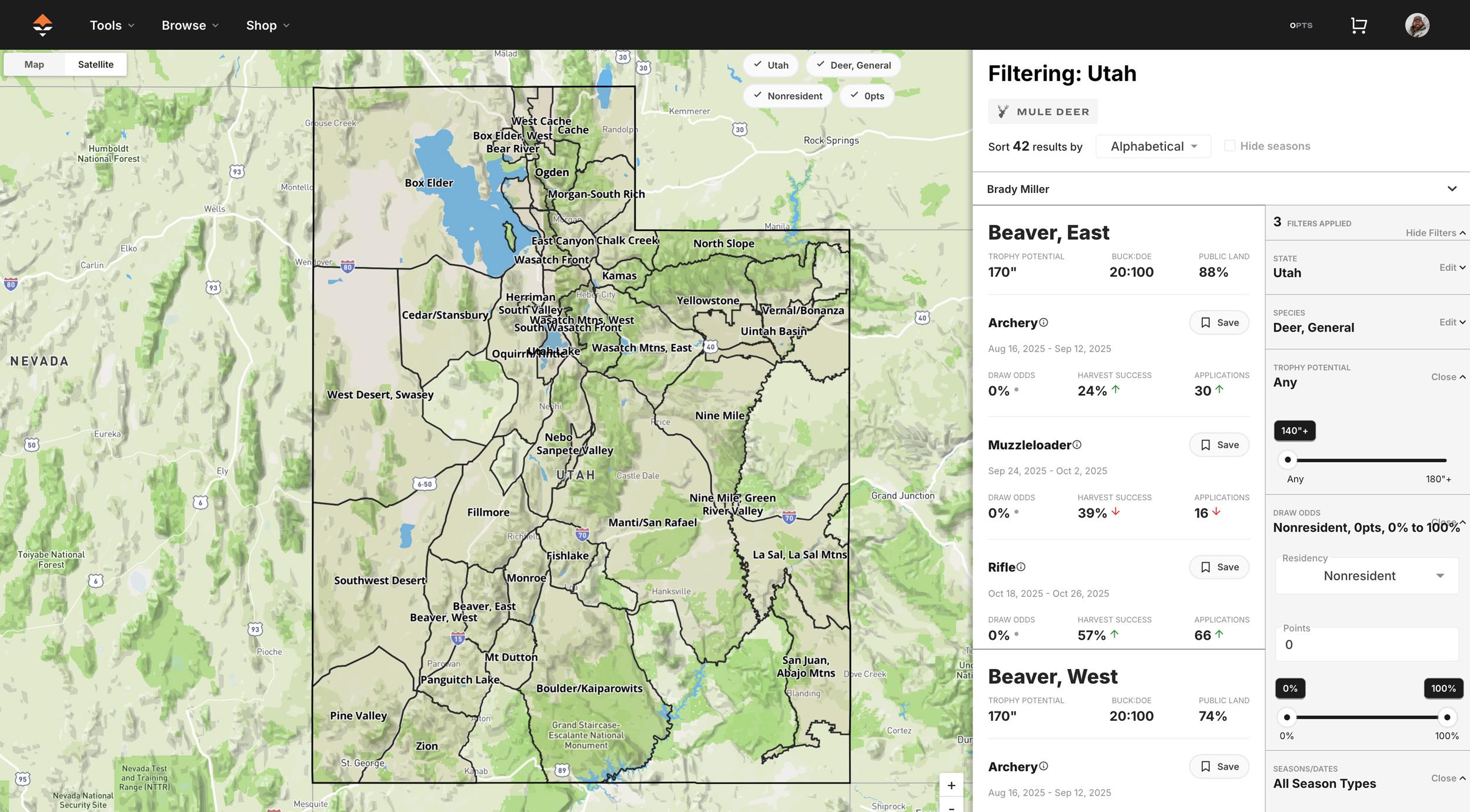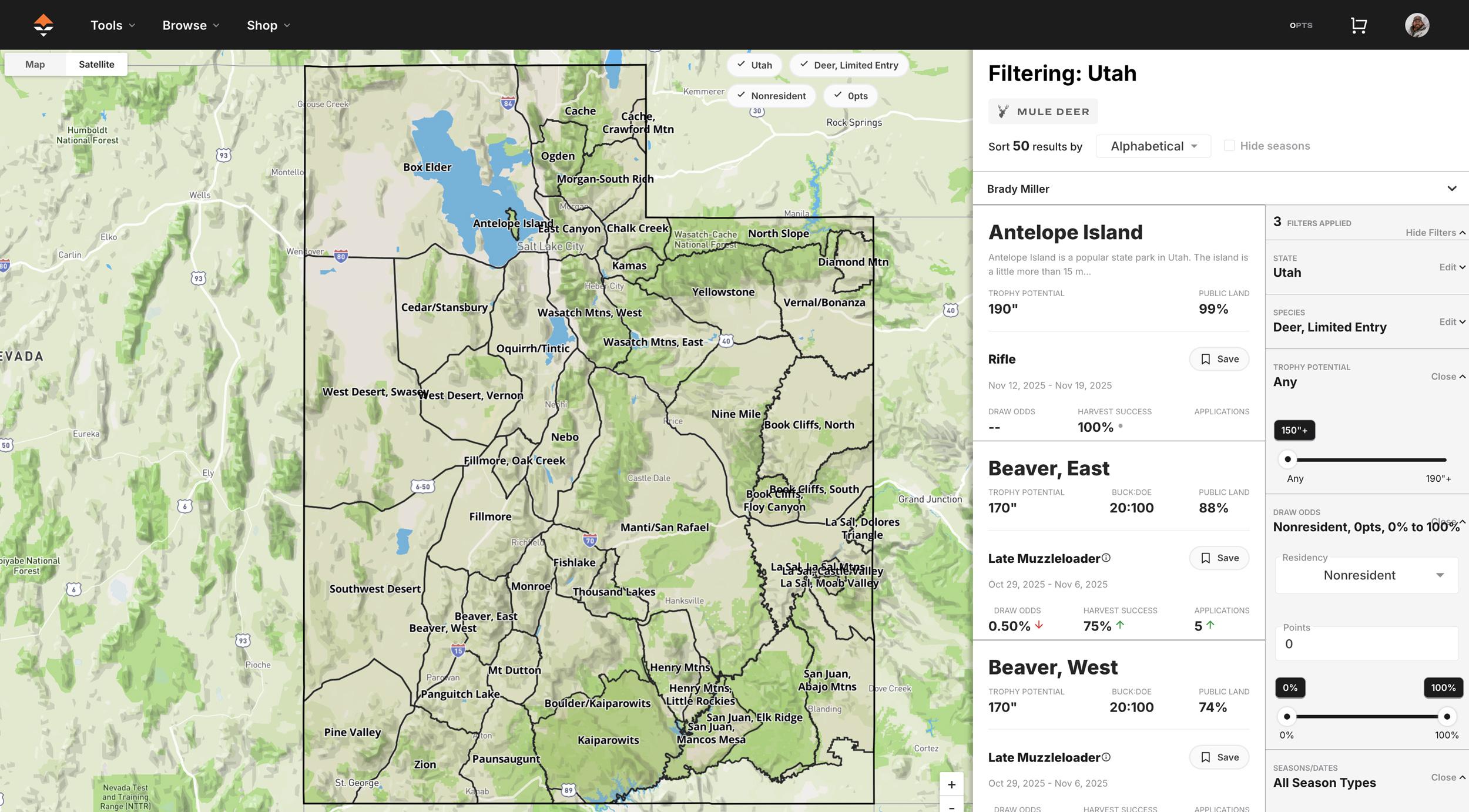




Utah general season deer map and hunting research example on GOHUNT.

Utah deer limited entry map and hunting research example on GOHUNT.
Utah is home to some of the best big game hunting opportunities in the West. Whether you're chasing high-country mule deer or rut-crazed bull elk, understanding the difference between general season and limited-entry tags in Utah is key to planning a successful hunt.
General season tags are Utah’s bread and butter for hunters looking to get out in the field more often. These tags are available for species like general season mule deer, general season elk, and general season spike elk, typically you'll experience more hunters in the field on general season hunts. Depending on the unit and species, these tags may be available through the draw, as over-the-counter (OTC) purchases, or during leftover tag sales.
These hunts are ideal for those who want to hunt every fall, and these hunts are managed for opportunity. If you're willing to put in the work—scouting, hiking deep, and hunting smarter—you can still find success and quality animals on general tags. Hunters must apply during the annual draw and can build preference points each year they’re unsuccessful (or you can apply for a preference point only), improving their odds over time.
Also, in terms of deer, preference points are used for general season deer hunting in Utah. So don’t confuse this with bonus points, as those are for the limited-entry hunts.
Also, there are two different types of general season deer options. You have general season deer, and you have dedicated hunter deer. Note that applicants can no longer apply for both general season deer and dedicated hunter deer hunts in the same year. They can only apply for one or the other.
Limited-entry tags are highly sought after and much tougher to draw. These hunts are designed to provide a higher-quality experience, often featuring older age-class animals, better buck-to-doe ratios and bull-to-cow ratios, and reduced pressure. Utah offers limited-entry hunts for elk, deer, and antelope, with the best units regularly producing trophy-class animals. Also, limited-entry hunts are for Utah’s once-in-a-lifetime species like sheep, moose, mountain goat, and bison.
Key points to remember in regards to bonus points:
Hunters must apply during the annual draw and can build bonus points each year they’re unsuccessful (or you can apply for a bonus point only), improving their odds over time. It can take several years—or even decades—to draw some of the top-tier tags, depending on the unit and species.
For serious hunters who dream of putting a true giant on the ground, limited-entry tags are the golden ticket. These hunts often require deep research, scouting, and logistics—but the payoff can be worth it.
If you're newer to western hunting or want consistent hunting opportunities, general season hunts are the way to go. If you're targeting high-end trophies or a next-level hunting experience, limited-entry hunts are worth the wait. Remember that you can apply for both each year, but the general is the one you actually have a chance to hunt more often when compared to the long wait of limited-entry hunts. So keep in mind, it can be an extremely long wait for limited-entry hunts in Utah, which is why you should decide if applying for them is worth it.
At GOHUNT, we help you make informed decisions based on your goals, point totals, and desired experience. With Insider, you can dive into unit data, harvest success, buck:doe ratios, draw odds, and much more to figure out where to apply—and when it’s your time to strike.
Remember that Utah utilizes two point systems for its draw: bonus and preference points. Bonus points are used for limited entry and once-in-a-lifetime applications, and preference points are used for the general season buck deer and antlerless hunts. You can apply for both types of systems in the same year, but remember, they are used for different hunts in a sense.
If you want to learn even more about the Utah draw system, check out the article below:
Want to maximize your odds or understand where your points will take you? If you're an Insider member, you also get access to our Insider-only Application Strategy articles that are packed with information.
Pros: Can be slightly easier to obtain, more frequent hunting opportunities, and great for building experience or introducing new hunters.
Cons: Higher hunting pressure, often lower trophy potential.
Nonresidents may apply and build bonus points for all available species.
Residents may only apply for one limited entry species: elk, antelope, or deer. They may also apply for one once-in-a-lifetime species: moose, bighorn sheep, mountain goat, or bison.
Pros: Better animal quality, less competition, prime dates.
Cons: Long wait times to draw, once-in-a-decade chances for premium units in most cases.